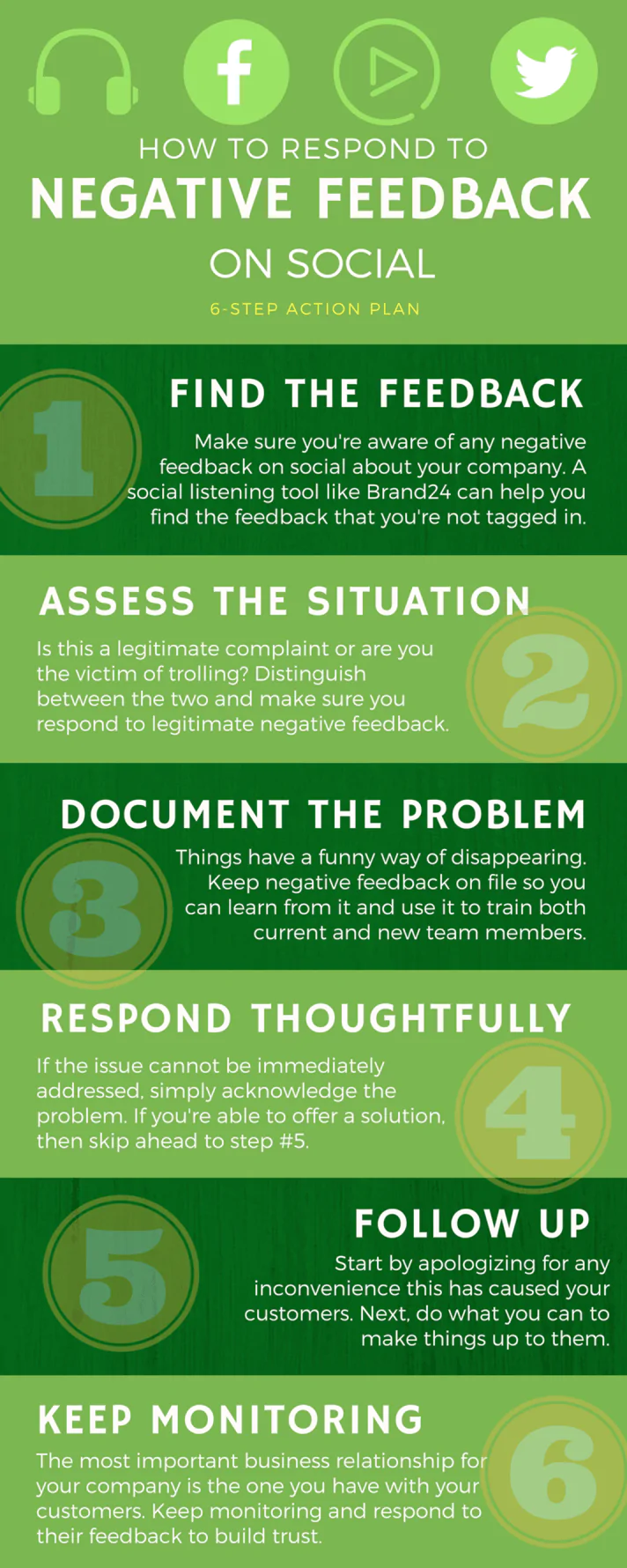How to Respond to Negative Feedback on Social: 6-step Action Plan [Infographic]
Negative feedback is unavoidable.
Chances are, if you think that your company is one of the lucky few that has yet to receive any, it only means you haven’t seen it. (Most likely, your customers simply didn’t tag you in their posts, leaving you blissfully unaware of any problems.)

So what do you do when you receive (or find) negative feedback on social, for all to see? Don’t despair – all is not lost. Keep calm and run through the 6-Step Negative Feedback Action Plan:
#1. Find the feedback
The first and most important step. Before you can fix a problem, you have to know it’s there.
Sometimes your customers will make this easy for you and send you negative feedback directly, or they’ll tag your company in a post.
Other times, the problem won’t be so easy to detect. According to Twitter statistics:
Only 3% of people who complain about a company on-line will actually tag that company in their posts.
Social listening can help you stay on top of the other 97% by alerting you to any negative on-line mentions of your brand.
Once you’ve been notified of negative feedback, proceed to the next step:
#2. Assess the Situation
Is this a form of trolling? Or is it legitimate feedback? (There’s a difference between a complaint and an insult, especially in terms of how they should be handled.)
- If you’re the victim of trolling, exercise caution. Trolls feed on negativity, and their criticism is rarely constructive. Most of the time, I’ll advocate for responding to negative (and positive!) feedback, but trolling is the rare instance where I’d strongly suggest that you take a step away from the situation and give it some space. For your own good, do not feed the trolls.
- Now, if you find a real complaint from a real customer, that’s a different story. This is where you need to focus your energies and make sure you provide a response.
Use your common sense to distinguish between trolling and real feedback. Once you’ve filtered out the trolling, move on to the next step.
#3. Document the problem

For the same reasons that the police will document and photograph a crime scene, you should too, because:
- Evidence disappears. The negative feedback could be tampered with (there might be a bug on the page, or the message could be edited) and then you won’t know what it was truly about.
- The customer behind the original post could feel remorse later about posting negative feedback on social and delete it. (In case you think this solves your problem, it doesn’t. The problem’s still there. You just won’t know about it if you didn’t already see the message. Having a problem and not knowing about it is 10X worse.)
Documenting the negative feedback will also give you something concrete to use for training purposes later. Both current and future team members can learn from this exchange, so keep it on file. It’s pretty much a guarantee that you’ll refer back to it later.
#4. Respond thoughtfully

- Acknowledge the problem – If it’s not an issue you can address immediately, just let your customers know that you’ve seen their message. A generic “Hi _____, we’re really sorry to hear about this. We’re working on a fix now!” will suffice when making initial contact. It’s certainly better than no response at all.
Keep in mind that an impersonal response like the one above only goes for situations that cannot be immediately addressed. If it’s something that can be taken care of right away, then:
- Address the problem – After following steps #1-3, if you already know how to handle things and are able to offer a solution, please skip ahead to step #5 and follow up.
#5. Follow up

- Apologize – Is your company at fault? Apologize. Acknowledge the inconvenience that you’ve caused your customers and you’ll save yourself a lot of trouble ahead. Even if the situation wasn’t directly caused by your company, but is still connected to your brand, now isn’t the time to search for excuses.
- Make up for it – If possible, offer the customer something to make up for their inconvenience. If applicable, you could extend their membership free of charge, offer them a free upgrade, or replace a product that has failed to live up to its standards.
The point is, you need to do everything you can to decrease customer dissatisfaction. And visibly, for all to see. This way, audiences who may have seen the original piece of negative feedback also have a chance to see the professional way that your company handles it.
Things happen. If you haven’t run into negative on-line feedback yet, it’s just a matter of time.
This is a fact that both companies and customers are aware of, so while your customers won’t be completely surprised by a malfunction (not to say that they won’t still be disappointed), they will be eagerly awaiting your response.
How you handle the situation is of utmost importance. A small token of your appreciation for their support can go a long way in maintaining it. Need I remind you?
It costs 5X more to acquire a new customer than it does to retain an existing one.
#6. Keep monitoring
So, you’re on top of things and have followed through with the first 5 steps of your action plan for handling negative on-line feedback: you’ve found the feedback, acknowledged the problem, documented it, apologized and made up for any inconveniences, and followed-up with the customers as necessary. Phew.
You’ve been busy, but it doesn’t really stop there. An integral part of your success depends on your relationship with your customers, and this is definitely worth investing in.
Continue to track what your customers say about your brand on-line and handle any new negative feedback that comes up.
Monitor mentions of your brand with a social listening tool like Brand24 to receive real-time alerts of any negative on-line feedback about your company.
Keep in mind: customers don’t always tag businesses in their posts, negative or positive. But this doesn’t mean that they don’t expect a response.
Dealing with or preparing to deal with negative feedback? Refer to the infographic up top. Use it and respond to your customers.
Because behind each piece of negative feedback is a real person.
When your customers feel like they’ve been prioritized (can you really afford not to?), and you’ve done all that you possibly can to make it up to them, this won’t go unnoticed.
Even though it might have started with negative feedback, the way you handle it (and the key is to respond) can actually help you build trust for your brand among your audience – including dissatisfied customers.
Keep step #1 of the Negative Feedback Action Plan in effect at all times and prevent a crisis before it has a chance to escalate.






![What is Brand Awareness? Guide & 9 Powerful Tactics to Build It [2022]](png/15-the-ultimate-guide-to-brand-awareness-1400x660x2-640x300.png)

